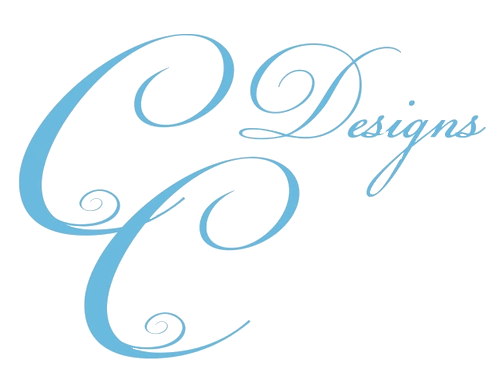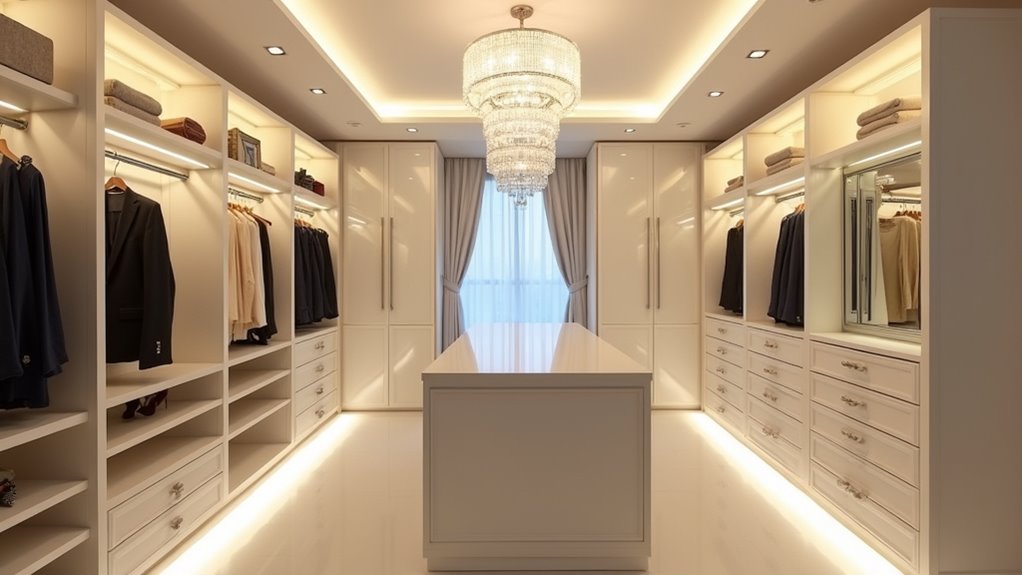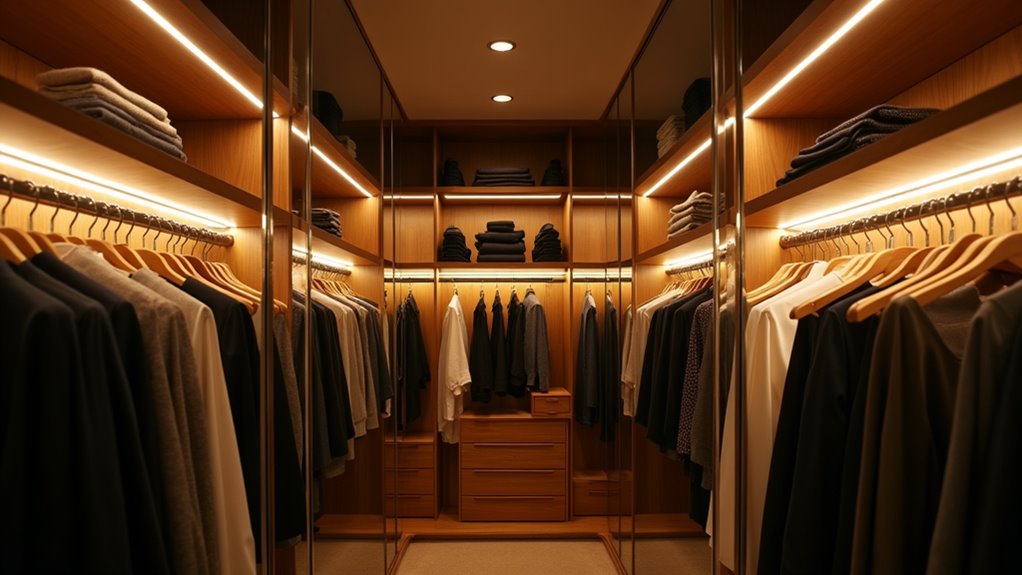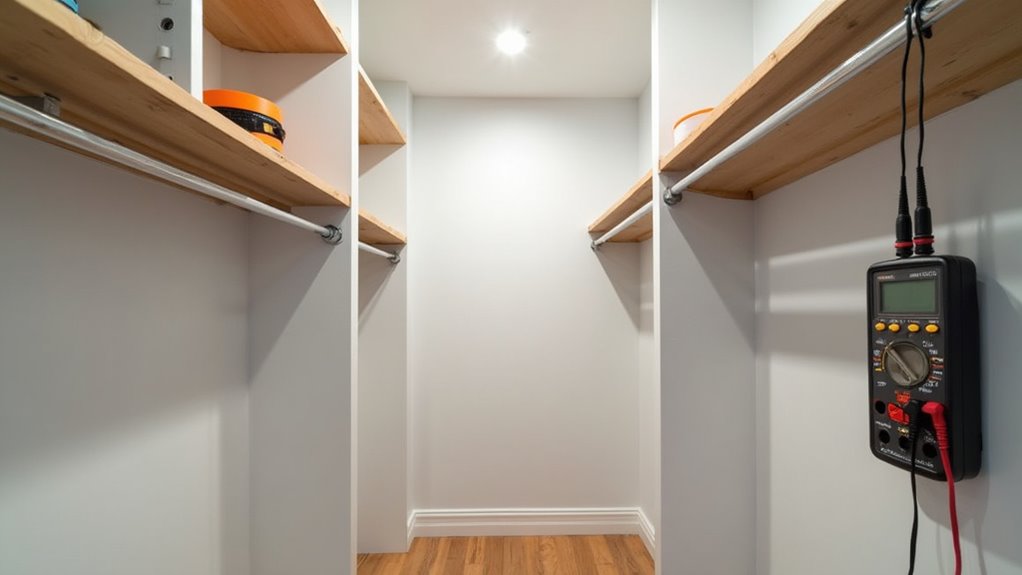LED flush-mount and recessed fixtures rated at 3000-4000K with CRI above 90 deliver the most effective closet illumination. You’ll need 100-200 lumens per square foot, achieved through central overhead fixtures in spaces under 40 square feet or recessed grid layouts for larger walk-ins. Supplement with LED strip lighting beneath shelves and motion-activated controls for hands-free operation. This combination guarantees accurate color rendering, optimizes headroom, and eliminates shadows across garment zones. The following sections explore strategic placement techniques and automation options that transform standard storage into boutique-worthy spaces.
Understanding the Role of LED Technology in Modern Closet Lighting

As closet design evolves from purely functional storage to curated spaces that augment daily routines, LED technology has emerged as the definitive lighting solution for these specialized environments. You’ll benefit from energy saving performance that reduces consumption by up to 75% while delivering over 25,000 operational hours. LEDs convert input power directly to illumination rather than heat, ensuring minimized fire hazards critical in enclosed configurations. Their superior color rendering index accurately displays textile hues and textures, while directional output concentrates light precisely where you need it. Available in strips, puck lights, bars, and recessed fixtures, LEDs integrate seamlessly into shelving systems and drawer interiors. The durability of LED fixtures makes them resistant to shocks and vibrations, maintaining reliable performance even with frequent door movements and closet activity. Flexible LED strips enable creative lighting solutions that contour around corners, wrap under shelves, and illuminate awkward angles within closet architecture. Smart-enabled options support motion sensors and automated controls, transforming your closet into an intelligent, responsive environment that combines safety, efficiency, and design sophistication. Strategic placement of LEDs creates boutique-like atmospheres that showcase your wardrobe’s fabrics and colors with precision.
Selecting Fixture Types Based on Closet Size and Layout
Selecting the appropriate fixture type requires evaluating your closet’s dimensions, configuration, and functional zones to guarantee adequate illumination without shadow gaps. Small reach-in closets demand compact, single-fixture solutions that optimize vertical clearance, while walk-in spaces benefit from multi-fixture layouts that address distinct areas for hanging, shelving, and dressing. Custom configurations, including L-shaped, U-shaped, or narrow layouts, necessitate strategic fixture placement and directional lighting to eliminate dark corners and provide uniform coverage across all storage zones. Flush mounts deliver a streamlined profile ideal for closets with limited ceiling height, preventing head clearance issues while maintaining clean sightlines. Recessed lighting offers a space-saving design that maintains an uncluttered appearance, particularly effective in larger closets where multiple can lights provide even coverage throughout the space. Adjustable recessed fixtures enable directional control to highlight specific storage areas such as shoe racks, accessory displays, or jewelry compartments.
Small Reach-In Closet Solutions
When outfitting a small reach-in closet, fixture selection directly impacts both functionality and spatial efficiency. Flush mount ceiling fixtures and recessed lighting deliver ideal lighting recommendations for tiny closets by maximizing headroom while providing broad, unobstructed coverage. These low-profile installations prevent physical intrusion into limited square footage.
LED strip lighting offers stylish fixtures for petite spaces when mounted under shelves or along closet rods, delivering targeted illumination without consuming vertical clearance. Motion-activated options eliminate manual switching in confined quarters, while battery-operated fixtures bypass wiring constraints common in rental situations.
Prioritize LED technology with 80+ CRI ratings and 3000-4000K color temperatures to guarantee accurate garment identification. Vertical LED strips along edges minimize shadows, and dimmable controls provide adjustable brightness. Smart lighting systems enable remote control and programming for enhanced convenience in compact closets. Modular night foot lamps with sensors provide hands-free illumination at floor level for visibility during nighttime access. For optimal placement, position recessed lights just inside the closet opening and angle them slightly towards the back to illuminate the entire depth. Avoid protruding fixtures that compromise usable space or create collision hazards.
Walk-In Closet Lighting Strategies
Walk-in closets demand fixture selections calibrated to spatial dimensions and architectural configuration rather than standardized lighting approaches. Compact spaces under 40 sq. ft. require overhead fixtures delivering 200-400 lumens, while mid-sized layouts (40–100 sq. ft.) necessitate layered systems combining central fixtures with wall sconces for complete surface illumination. Large walk-ins exceeding 100 sq. ft. benefit from grid-pattern recessed lighting generating 1000+ lumens.
| Closet Size | Primary Fixture | Supplemental Options |
|---|---|---|
| <40 sq. ft. | Compact overhead (200-400 lumens) | LED strips |
| 40-100 sq. ft. | Central fixture + sconces | Under-shelf task lights |
| 100+ sq. ft. | Grid recessed lights (1000+ lumens) | Track lighting |
| High ceilings | Wall-wash recessed | Vertical sconces |
| Shadow zones | Spotlights | Floor baseboards |
Fixture versatility becomes critical when addressing corners, shelving, and vertical storage requiring targeted task illumination. Track lighting systems offer adjustable beam directions that can be mounted lengthwise or crosswise to illuminate specific focal points throughout the closet. Proper lighting placement also prevents shadows in drawers, ensuring every storage compartment remains fully visible during daily use.
Custom Layout Fixture Considerations
Beyond general lighting principles, fixture selection depends on precise measurements of your closet’s footprint and three-dimensional configuration. Apply the length-plus-width formula to determine diameter thresholds: sum dimensions in feet to establish fixture size in inches. Small closets under 100 square feet require 6–10 inch flush mounts, while mid-sized spaces accommodate up to 14-inch fixtures. L-shaped and U-shaped walk-ins demand multiple fixtures at corners for uniform coverage, offering flexibility in fixture positioning across complex geometries. Double-rod configurations benefit from ambient ceiling lighting paired with under-shelf LED strips, ensuring integration with storage solutions at multiple vertical levels. Limit fixture diameter to one-third of closet width to prevent spatial imbalance. Match ceiling height to mount type: flush for low clearances, semi-flush or compact chandeliers for taller enclosures. Select fixtures with adjustable chains or rods to accommodate varying ceiling heights and maintain optimal positioning as storage needs evolve. Preview fixture proportions using cardboard cutout templates positioned on the ceiling before committing to purchase. Battery-operated LED lighting eliminates the need for existing wiring in closets without electrical infrastructure.
Strategic Placement Techniques for Shadow-Free Illumination
Since shadows compromise both functionality and aesthetics in closet environments, understanding fixture positioning becomes essential for designers and homeowners pursuing suitable illumination. Position overhead LEDs directly above clothing racks while maintaining 3-4 foot spacing intervals to eliminate dark zones. Avoid mounting fixtures behind obstructions, hanging garments or storage bins eclipse light distribution and create unintended shadow clusters.
Integrate supplemental side lighting on vertical surfaces at equal heights, ensuring beam overlap across shelving units. This technique addresses lateral shadows that overhead sources can’t reach. For cabinet interior illumination, install linear LED strips beneath each shelf level, staggered evenly by width to achieve uniform exposure on storage surfaces. Target 100-200 lumens per square foot throughout the closet space to ensure adequate brightness for visibility and organization.
Conduct pre-installation height and layout evaluations to verify full-surface coverage. Regular fixture maintenance preserves appropriate output, preventing dim areas that develop over time.
Choosing the Right Color Temperature for Accurate Clothing Evaluation
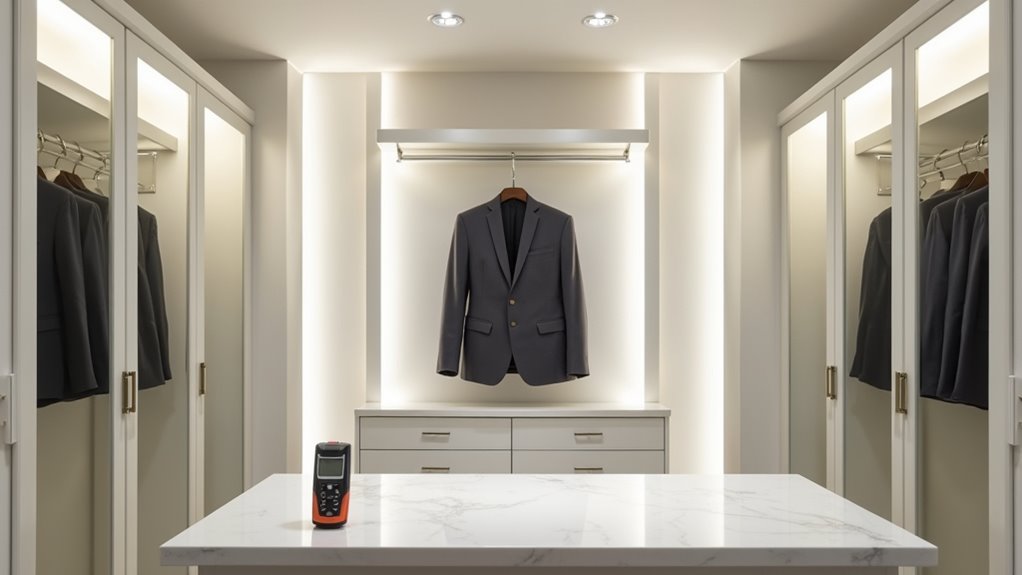
Proper fixture placement eliminates shadows, but light quality determines whether you can accurately assess garment colors and coordinate outfits effectively. You’ll need neutral white (4000K–4500K) LEDs with CRI above 90 for garment undertone evaluation and proper color rendering for wardrobe coordination. Warm white (<3500K) distorts reds and browns with yellowish tints, while cool white (>5000K) exaggerates blues and dulls warm hues.
| Color Temperature | Application |
|---|---|
| 4000K–4500K | Ideal for true-to-life garment evaluation |
| <3500K | Ambient only—distorts neutrals and whites |
| >5000K | Overemphasizes cool tones, dulls warm fabrics |
| 2700K–6500K tunable | Maximum flexibility for varied lighting scenarios |
Tunable white fixtures enable real-time adjustments, ensuring wardrobe selections appear consistent under different environmental conditions.
Recessed Versus Surface-Mounted Options for Space Optimization
When selecting between recessed and surface-mounted fixtures, you’ll face tradeoffs between spatial efficiency, installation complexity, and aesthetic integration. Recessed installations deliver a flush profile that optimizes headroom and creates an uncluttered, minimalist appearance, ideal for compact closets and luxury applications. However, they demand precise cutouts, increased labor costs, and ceiling cavity access, making them impractical for retrofits. Surface-mounted alternatives offer straightforward installation with minimal structural modifications, supporting accessibility requirements through easier lamp replacement and maintenance. They’re cost-effective and versatile, accommodating decorative styles where fixtures become design focal points. Both options provide LED fixture sustainability and longevity, yet recessed solutions excel in targeted, shadow-free distribution, while surface mounts enable flexible, layered lighting schemes. Your choice hinges on spatial constraints, budget, and whether you prioritize visual seamlessness or installation simplicity.
Incorporating Smart Controls and Automation Features
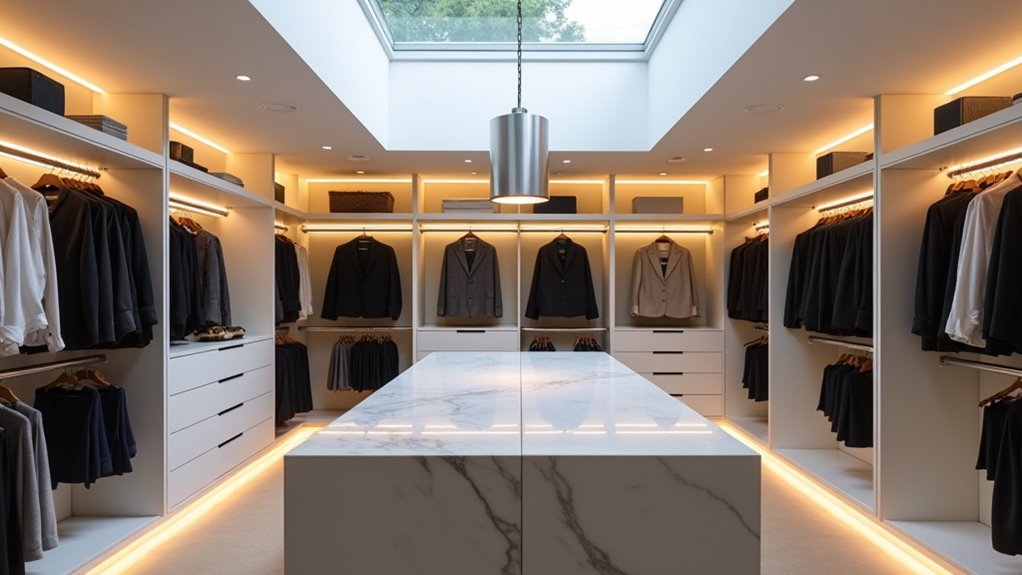
Smart controls and automation features transform closet lighting from static utility into responsive, energy-intelligent systems that adapt to occupancy patterns and user preferences. Motion sensor integration delivers hands-free operation through PIR technology that detects infrared radiation and movement, triggering instant activation while implementing automatic shutoff after 30 seconds of inactivity. This approach eliminates traditional wall switches in confined spaces where reach accessibility proves challenging.
App-based scheduling extends functionality beyond simple automation, enabling remote brightness adjustment, color temperature control, and predetermined timing protocols. You’ll achieve seamless integration with virtual assistants for voice command operation while maintaining compliance with building codes requiring automated lighting solutions. LED strip systems and smart wardrobe rails incorporate these technologies directly, creating inclusive automation that optimizes energy consumption while enhancing spatial functionality through targeted, sensor-responsive illumination.
Balancing Ambient, Task, and Accent Lighting Layers
Layering ambient, task, and accent lighting transforms closet spaces from single-function storage into multi-dimensional environments where illumination serves both practical demands and aesthetic objectives. You’ll achieve ideal lighting zone integration by combining ceiling-mounted fixtures for general coverage, under-shelf LED strips for precise visibility, and spotlights for architectural emphasis. This balanced lighting hierarchy prevents flatness while supporting garment selection, grooming tasks, and display curation simultaneously.
Install layered controls that allow independent adjustment of each fixture type, adapting intensity and focus to varying activities throughout the day. Strategic placement eliminates shadows and glare while maintaining consistent color temperature across zones, typically 2700K–3500K for warmth. Utilize high-CRI fixtures (90+) in task areas for accurate color perception, and coordinate fixture styles to preserve design cohesion throughout your closet system.
Design-Forward Fixtures That Enhance Luxury and Boutique Aesthetics
Beyond functional illumination, fixture selection establishes the aesthetic vocabulary of your closet environment, transforming utilitarian storage into a curated retail experience that rivals high-end boutiques. Ketra lighting systems deliver dynamic color rendering that adapts throughout the day, guaranteeing garments display their true hues under ideal spectral conditions. Sculptural statement pieces, from ribbon chandeliers to postmodern geometric designs, anchor the space with architectural presence while integrated millwork lighting maintains clean sightlines.
| Fixture Category | Design Application |
|---|---|
| Statement Chandeliers | Central focal points with geometric or artistic forms |
| Integrated Millwork | Seamless LED strips within shelving and cabinetry |
| Smart Mirrors | Customizable illumination for grooming and styling |
Edge-lit wafer downlights and lighted hanging rods provide targeted accent illumination, while motion-activated systems guarantee seamless operation. Glass insert shelves extend horizontal lighting reach, creating continuous visual flow throughout vertical storage zones.
Energy Efficiency and Long-Term Maintenance Considerations
While sculptural fixtures and dynamic color rendering establish visual hierarchy, the operational infrastructure of your closet lighting directly impacts lifecycle costs and environmental performance. High quality LED selection delivers 25,000–50,000 operating hours with up to 85% energy reduction versus incandescent alternatives, while motion sensors and dimming protocols extend component longevity by minimizing full-intensity stress. Modular configurations enable zone-specific illumination, eliminating wasted electricity in unused areas. Battery-powered and plug-in options eliminate rewiring expenses during retrofits, and low heat emission, often under 10.2W per fixture, reduces HVAC demand in enclosed spaces. LED disposal considerations remain simplified; mercury-free construction streamlines end-of-life protocols. Energy Star and UL certifications guarantee code compliance, while selectable color temperatures prevent premature fixture obsolescence, protecting your capital investment across decades of continuous operation.
Frequently Asked Questions
Can Closet Lighting Fixtures Be Safely Installed in Humid Walk-In Closets?
Yes, you can safely install closet lighting in humid walk-in closets by specifying moisture-resistant fixtures with UL Damp ratings. These humidity proof installations are engineered to withstand condensation without compromising electrical integrity. You’ll need to verify manufacturer specifications confirm damp-location suitability, as standard dry-rated fixtures risk corrosion and code violations. Prioritize LED fixtures labeled “closet rated” and “damp rated” for optimal performance. Maintain proper clearances per NEC 410.16 and guarantee adequate ventilation to support fixture durability in moisture-prone environments.
What’s the Ideal Lumens Output for Small Versus Large Closet Spaces?
For small closets under 25 square feet, you’ll want a suitable lumen range of 500–800 lumens, achievable through compact flush-mount LEDs or single recessed fixtures. Large walk-in closets exceeding 80 square feet require 1,500–2,000+ lumens, best delivered via multiple recessed downlights or linear LED strips. Appropriate fixture types include dimmable integrated panels for ambient coverage and adjustable gimbals for task zones. Dark finishes necessitate higher output, potentially doubling your lumen requirements for adequate illumination.
Are Battery-Operated Closet Lights Bright Enough for Daily Wardrobe Selection?
Battery-operated closet lights typically provide 60–100 lumens per fixture, which may prove insufficient for precise wardrobe selection in larger spaces. You’ll achieve better results by installing multiple wireless motion-activated lights or selecting high-output LED strips (up to 850 lumens) for adequate color rendering and detail visibility. For ideal performance, consider rechargeable task-focused illumination options positioned strategically throughout your closet. Single puck lights work for basic navigation but won’t deliver the brightness you need for daily clothing coordination.
How Do I Prevent LED Strip Lights From Creating Glare on Mirrors?
You’ll prevent LED strip glare on mirrors through strategic placement and diffusion techniques. Position strips at angles away from reflective surfaces, using cove lighting or recessed channels for indirect illumination. Install frosted covers or diffusing lenses to create a diffuse light source that scatters harsh reflections. Mount fixtures outside direct sightlines, ensuring they’re not visible in mirror reflections. Consider dimmers for brightness control and anti-reflective coatings on surrounding surfaces to minimize secondary glare effects.
What’s the Average Installation Cost for Professional Closet Lighting Systems?
You’ll typically spend $230–$300 per fixture for professional closet lighting systems, with labor averaging $200 per installation. Average installation costs depend on your fixture selection; puck lights average $265 installed, while LED strips range $200–$400 complete. Professional lighting expertise guarantees proper electrical integration, switch placement, and fixture positioning that optimizes functionality. Complex installations requiring new wiring or multiple fixtures can reach higher price points, but you’re investing in superior illumination design and code-compliant execution.
